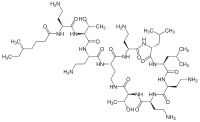
Photo from wikipedia
Background Despite a wide range of biological treatments (bDMARDs) in the management of rheumatoid arthritis (RA), some patients fail in different lines of treatment. Currently, there is no consensual definition… Click to show full abstract
Background Despite a wide range of biological treatments (bDMARDs) in the management of rheumatoid arthritis (RA), some patients fail in different lines of treatment. Currently, there is no consensual definition of multiresistance to bDMARDs in RA. Objectives The aim of our study was to describe the characteristics of « multiresistant » patients and to establish associated factors with multiresistance to bDMARDs in RA. Methods In this observational and retrospective study were identified patients with RA admitted for administration of a bDMARD at Rouen University Hospital (France) between January 2007 and July 2017 (sources : diagnostic coding using International Classification of Diseases 10th revision and traceability of intra-hospital pharmacy). In the absence of a consensual definition, multiresistance to bDMARD was defined in this study by failure, primary and/or secondary, to at least 2 bDMARDs. The clinical and paraclinical characteristics of these patients at the initiation of the first bDMARD were collected using data from their standardized monitoring, then compared to those of patients who received a single bDMARD effective for 10 years or more, constituting the “responder” group. Results We identified 794 patients: 385 constituted our active RA file under bDMARD, 192 patients excluded for different reasons (6 patients not fulfilling the ACR/EULAR 2010 criteria, 18 followed in another department, 45 for missing data at bDMARD’s initiation, 50 not found in computerized file, 73 for whom the expected bDMARD was never started) and 217 lost to follow-up. Among our active RA file under bDMARD (385 patients), 53 were « multiresistant » (at least 2 bDMARDs failed), and 50 patients received a single and effective bDMARD for 10 years or more, after excluding some patients for missing data (Figure 1). The mean age of « multiresistant » patients at initiation of bDMARD was 50.3 years (±13.2 years), and the sex ratio was 2.8 women/1 man. They presented erosive RA (77.4%), rheumatoid factor and anti-citrullinated peptide antibodies positive (73.6%), highly active (median number of tender and swollen joints 8/28, median visual analog scale disease activity 70/100, median C-reactive protein (CRP) 21 mg/L, mean Disease Activity Score 28 CRP mean 5.36±1.28), and with high functional impact (Health Questionnaire Median Assessment: 1,500/3). The age of disease onset was significantly later in « multiresistant » patients than in « responder » patients (43±14.2 years versus 37.9±10.7 years, p = 0.042). No demographic, anamnestic, clinical and paraclinical characteristics differed significantly between « multiresistant » and « responder » patients. Conclusion It is an original work, counting in the literature as a single similar study [1], with nevertheless significant methodological differences. There is no consensual definition of multiresistance to bDMARD in RA, and its mechanisms remain misunderstood. Identifying predictive factors would make it possible to early identified patients with a refractory profile, in order to adapt the therapeutic strategy. Multidrug resistance in RA remains one of the challenges in the management of this pathology. Reference [1] Kearsley-Fleet L, Davies R, De Cock D, Watson KD, Lunt M, Buch MH, et al. Biologic refractory disease in rheumatoid arthritis: results from the British Society for Rheumatology Biologics Register for Rheumatoid Arthritis. Ann Rheum DisEpub ahead of print : 8 July 2018 Disclosure of Interests None declared
Journal Title: Annals of the Rheumatic Diseases
Year Published: 2019
Link to full text (if available)
Share on Social Media: Sign Up to like & get
recommendations!